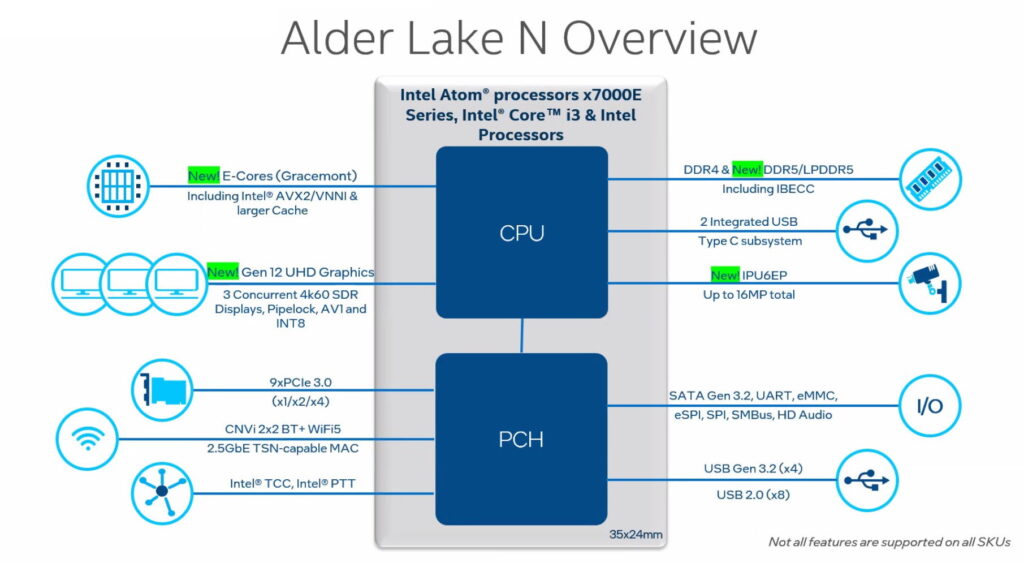Intel recently replaced they’re confusing Celeron and Pentium brands with something called N Series CPU’s. Put simply, N series CPU’s have no “Performance” cores. They are exclusively “Efficiency” cores and that is actually a good thing.
If you weren’t already aware the world’s largest design house for CPU’s is named ARM, and years ago ARM came out with a concept they called “Big Little”. Big CPU cores handled compute intensive processes and Little CPU cores ran less intensive mundane tasks. They did this because ARM sells mostly in mobile devices like cell phones and tablets, so power management is a very big issue and if they can move noncompute intensive tasks to to extremely low power CPU cores they can really extend the life of your battery. Intel copied this concept with they hold Performance and Efficiency cores.

You might think that efficiency cores are not very powerful and compared to top performance cores you’d be right. However intel claims that their efficiency cores on their latest cpus are about is powerful as fifth generation Core i5 cpus from about 2015, while using drastically less electricity.
So let’s get into some of the specifications of these new N series cpus. They are currently built on what Intel’s most current i5 and i7 cpus which were code named “Alder Lake” cleverly calling their efficiency core project “Alder Lake N”. These cores are built on which makes them unbelievably tiny and efficient.
Just because Intel cleared up the Celeron / Pentium brand confusion that doesn’t mean that they don’t want to maximize their profits by leveraging the “core” brand and you’ll notice Intel Core i3’s:
| Product Name | Marketing Status | Launch Date | Total Cores | Max Turbo Frequency | Cache |
| Intel® Core™ i3-N305 Processor (6M Cache, up to 3.80 GHz) | Launched | Q1’23 | 8 | 3.80 GHz | 6 MB |
| Intel® Core™ i3-N300 Processor (6M Cache, up to 3.80 GHz) | Launched | Q1’23 | 8 | 3.80 GHz | 6 MB |
| Intel® Processor N100 (6M Cache, up to 3.40 GHz) | Launched | Q1’23 | 4 | 3.40 GHz | 6 MB |
| Intel® Processor N200 (6M Cache, up to 3.70 GHz) | Launched | Q1’23 | 4 | 3.70 GHz | 6 MB |
| Intel® Processor N50 (6M Cache, up to 3.40 GHz) | Launched | Q1’23 | 2 | 3.40 GHz | 6 MB |
| Intel® Processor N97 (6M Cache, up to 3.60 GHz) | Launched | Q1’23 | 4 | 3.60 GHz | 6 MB |
| Intel Atom® x7213E (6M Cache, up to 3.20 GHz) | Launched | Q1’23 | 2 | 3.20 GHz | 6 MB |
| Intel Atom® x7211E (6M Cache, up to 3.20 GHz) | Launched | Q1’23 | 2 | 3.20 GHz | 6 MB |
| Intel Atom® x7425E (6M Cache, up to 3.40 GHz) | Launched | Q1’23 | 4 | 3.40 GHz | 6 MB |
Intels products now flow in this branding order:
- Atom
- N Series
- Core i3 N Series
- Core i3
- Core i5
- Core i7
- Core i9
- Core i9 Extreme
As you can see in the Intel Alder Lake N CPU Overview graphic below these little processors really are little powerhouses. They can run three 4K resolution screens at the same time, support DDR4 or DDR5 memory and can encode decode video with Intel AVX2.

So in addition to consumer grade uses that you will see branded as Intel N or Intel Core i3 N, there are literally 10s of thousands of IoT (Internet of Things) uses. For instance, edge computing in which AI can be applied to a video stream right on the camera before it even gets to a datacenter are now very possible.



0 Comments